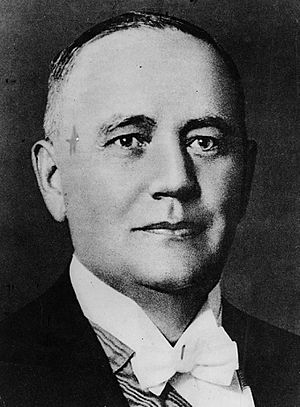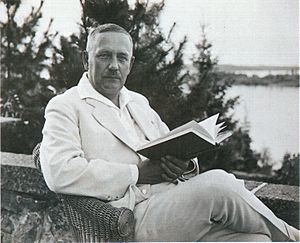Lauri Kristian Relander facts for kids
Quick facts for kids
Lauri Kristian Relander
|
|
|---|---|
 |
|
| 2nd President of Finland | |
| In office 2 March 1925 – 2 March 1931 |
|
| Prime Minister | Lauri Ingman Antti Tulenheimo Kyösti Kallio Väinö Tanner Juho Sunila Oskari Mantere Pehr Evind Svinhufvud |
| Preceded by | Kaarlo Juho Ståhlberg |
| Succeeded by | Pehr Evind Svinhufvud |
| Personal details | |
| Born | 31 May 1883 Kurkijoki, Finland (now in the Republic of Karelia, Russia) |
| Died | 9 February 1942 (aged 58) Helsinki, Finland |
| Political party | Agrarian League |
| Spouse | Signe Relander |
Lauri Kristian Relander (born May 31, 1883 – died February 9, 1942) was the second President of Finland. He served as president from 1925 to 1931.
Before becoming president, Relander was an important member of the Agrarian League. He worked as a member of the Parliament of Finland and even as its Speaker.
Many people remember Relander as one of Finland's less well-known presidents. He was seen as a quiet leader during a time when Finland faced many political problems at home. In foreign policy, Finland mostly kept to itself. However, Relander did a great job representing Finland abroad. He helped build good relationships with other countries, especially the Nordic countries. During his time as president, he also worked to keep peace in society. He wanted all political groups to follow the rules of democracy and the republic.
Contents
Early Life and Education
Lauri Kristian Relander was born in Kurkijoki, in a part of Finland called Finnish Karelia. His father, Evald Kristian Relander, was an expert in farming. His mother was Gertrud Maria Olsoni.
He was first named Lars Kristian. But during his school years, he changed his name to the more Finnish-sounding Lauri Kristian. In 1901, he went to the University of Helsinki. He studied farming, just like his father.
University Studies and Family
In 1905, Lauri earned his first university degree in philosophy. The next year, he got another degree in farming. In 1906, he also married Signe Maria Österman. They had two children, Maja-Lisa and Ragnar.
Lauri continued his studies and earned his master's degree in 1907. He focused on agricultural chemistry and economics. From 1908 to 1917, he worked as a researcher. He did important studies in farming. In 1914, he earned his highest degree, a Doctorate.
Early Political Steps
While studying and working, Relander also became active in politics. He joined the Agrarian League. He was elected to the Finnish Parliament in 1910 and served until 1913. He was elected again from 1917 to 1920. By 1917, he had become one of the main leaders of his party.
Becoming a Politician
After Finland became independent, Relander's political career grew. He was a key member of his party. He served on many important committees in Parliament.
In 1919 and 1920, Relander was chosen as the Speaker of the Eduskunta (the Finnish Parliament). Later in 1920, he became the Governor of the Province of Viipuri. However, he did not have enough support within his own party to become a government minister at that time.
Surprise Presidential Candidate
In 1925, Relander was chosen to run for president. This was a surprise because he was only 41 years old. Some of the party's most important leaders did not want to run, which helped Relander get the nomination.
Relander won the election in the third round of voting. He beat Risto Ryti, another candidate. Relander won partly because he was seen as less controversial than Ryti. Some people also believed that voters from the Swedish People's Party preferred Relander because his wife was a Finland Swede.
Other reasons for his win included strong opposition to the previous president, K. J. Ståhlberg. Also, Relander was an active member of the "Suojeluskunta," a volunteer military group. He was more social and talkative than Ryti, which made him seem more approachable.
Presidential Years

When Relander became president, he was young and did not have much political experience. Some politicians did not take him seriously. He did not have a strong political base or a clear plan for his presidency. This made his support even weaker.
Relander traveled a lot during his time as president. He made many state visits to other countries. This earned him the nickname Reissu-Lasse, which means "Travelling Lasse." People often compared him to the previous president, Ståhlberg, who was very different.
During Relander's presidency, governments were often weak and did not last long. This was common in many European countries at the time. Overall, Relander is remembered as a president who was not very strong. However, he was an idealist. He disliked the harshness of politics and preferred governments made of good people, even if they were a minority.
Key Actions as President
Even though he was not seen as a strong president, Relander did some important things:
- He allowed the Social Democrats to form a minority government from 1926 to 1927.
- He appointed Finland's first female cabinet minister, Miina Sillanpää. She became the Assistant Minister of Social Welfare.
- He dissolved Parliament twice. Once in 1929 over a disagreement about government workers' salaries. And again in 1930 to try and ban the Communist Party.
- He generally supported the far-right Lapua Movement at first. But he stopped supporting them when they began to kidnap political opponents. Relander later said his biggest mistake was shaking hands with the Lapua Movement leader, Vihtori Kosola, in 1930. This was seen as a sign of Relander's poor judgment.
- He remained good friends with the Social Democratic leader, Väinö Tanner.
End of Presidency
By late 1930, Relander knew he would not be re-elected. During the winter of 1930–31, he worked against his former party colleague, Kyösti Kallio. This helped Pehr Evind Svinhufvud, who had been Relander's Prime Minister, get elected instead.
Relander believed Kallio was not honest with him and tried to weaken his presidency. Kallio, on the other hand, thought Relander was an inexperienced politician with good ideas but not enough common sense. Their disagreement was due to their personalities and different political views. For example, Relander was more open to right-wing groups like the Lapua Movement, which caused problems for his presidency.
After his term as president ended in 1931, Relander became the General Manager of a fire insurance company for rural people. He held this job until 1942. Lauri Kristian Relander died in 1942 from heart failure. He was buried in the Hietaniemi Cemetery.
Legacy and Remembrance
Lauri Kristian Relander is remembered in Finland in a few ways.
- In 1959, a square in Helsinki's Kulosaari was named Relanderinaukio (Relander Square) after him.
- An abstract sculpture in his memory, created by Matti Peltokangas, was put up in Helsinki in 1996.
Honours and Awards
Relander received many awards from Finland and other countries.
Finnish Honours
 Finland : Grand Cross of the Order of the White Rose of Finland
Finland : Grand Cross of the Order of the White Rose of Finland
International Honours
 Sweden : Knight of the Royal Order of the Seraphim
Sweden : Knight of the Royal Order of the Seraphim Norway : Knight of the Royal Norwegian Order of Saint Olav
Norway : Knight of the Royal Norwegian Order of Saint Olav Denmark : Knight of the Order of the Elephant
Denmark : Knight of the Order of the Elephant Estonia : Cross of Liberty
Estonia : Cross of Liberty Estonia : Order of the Cross of the Eagle
Estonia : Order of the Cross of the Eagle Latvia : Order of the Three Stars, 1st Class with Collar
Latvia : Order of the Three Stars, 1st Class with Collar Poland : Order of the White Eagle
Poland : Order of the White Eagle Belgium : Order of Leopold
Belgium : Order of Leopold
Images for kids
See also
 In Spanish: Lauri Kristian Relander para niños
In Spanish: Lauri Kristian Relander para niños



